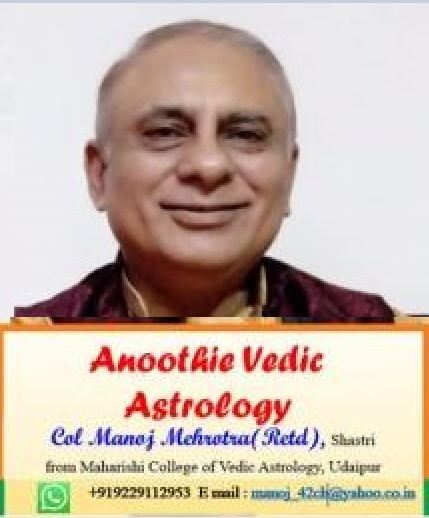IS BHARAT AND BAHRTIYA STILL IN MENTAL SLAVERY ??? – DOUBTS ON
VEDIC ASTROLGY NOT BEING SCIENTIFIC AND MATHEMATICAL !!!
A lot of atheists, rationales and non believers argue that Vedic Astrology (Jyotir Vigyana) is a myth, an orthodox guess work and has no scientific or mathematical basis. They say that it makes people backward….and stick to non productive things. This is a fall out of almost
2500 years of slave mentality which has convinced people that anything Indian is orthodox,
old, not modern and useless….Here are some facts for you to consider…
Calculations of orbital Periods of Planets – Long ago, much earlier than modern science
our Rishis calculated the orbital periods of planets viz one year for Sun, 12 years for Jupiter, 30 years for Saturn and so on. Even the calculation of positions of Rahu and Ketu are purely mathematical and calculated as per the orbital intercept positions of earth and moon.
Sun vs Moon – We have been always told that Sun is the most energetic planet and gives us energy, but in vedic astrology, Moon is proved to be most important as it is the ruling planet of water(which constitutes >75% of our body). The period of moon is 28 days, which is also the biological cycle time human body. Moon represents mother, who gives us life and is also the ruling planet of our inner self(also used in psychology). People with weak moon have restlessness, less inner peace and so on. In Vedic astrology, a day(tithi) changes when moon moves 12 degrees away from Sun thereby, completing one orbit in 30 days(including a day fro full moon and one for no moon)
Calculation of degrees of Nakshatra(constellations) – A horoscope represents 360 degrees, divided in 12 signs, giving a coverage of 30 degrees to each sign. There are 27
constellations (nakshatra) in vedic astrology, each covering 13 degree 20 mins and thus
covering 360 degree in all 12 signs. It is purely mathematical. The dasha periods are based on purely mathematical degrees extrapolated with orbital periods of planets.
Calculation of Degrees, Speeds and Transit of Planets – The vedic astrology considers
daily move of planets, their speeds and degrees covering their daily transits, which are purely scientific and mathematical. Thus Vedic astrology predictions are based on these placement of planets at the time of birth as well as daily position during transit of planets.
Rashtriya Panchang – Published by The Directorate General of Meteorology, Positional
Astronomy Centre(Ministry of Earth Sciences). This is an yearly publication since 1957-58
and brings out the position, degrees etc of Planets which are used in astrology. It contains
important astronomical information on sidereal time, equation of time, timings of sunrise,
sunset, moonrise, moonset, in addition to usual panchang information like tithi, nakshatra,
yoga, karana, transit time of the sun, moon and planets to nirayana rasis and nakshatras,
beginning of lagnas for central station of India, nirayana longitudes of the sun, moon, planets and rahu etc. Items like Julian day number, kali ahargana, moon’s age, declination of the sun, midday time and also beginning of lagnas around sunrise time. This is aligned to the first day of the hindu year that is Pratipada(First tithi) of Hindu year.
Courses on Vedic Astrology – India’s University Grants Commission and Ministry of Human Resource Development decided to introduce “Jyotir Vigyan” (i.e. jyotir vijñāna) or “Vedic astrology” as a discipline of study in Indian universities, stating that “vedic astrology is not only one of the main subjects of our traditional and classical knowledge but this is the discipline, which lets us know the events happening in human life and in universe on time scale” in spite of the complete lack of evidence that astrology actually does allow for such accurate predictions. The decision was backed by a 2001 judgment of the Andhra Pradesh High Court, and some Indian universities offer advanced degrees in astrology.



